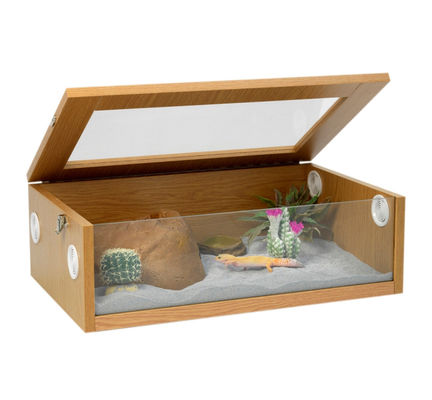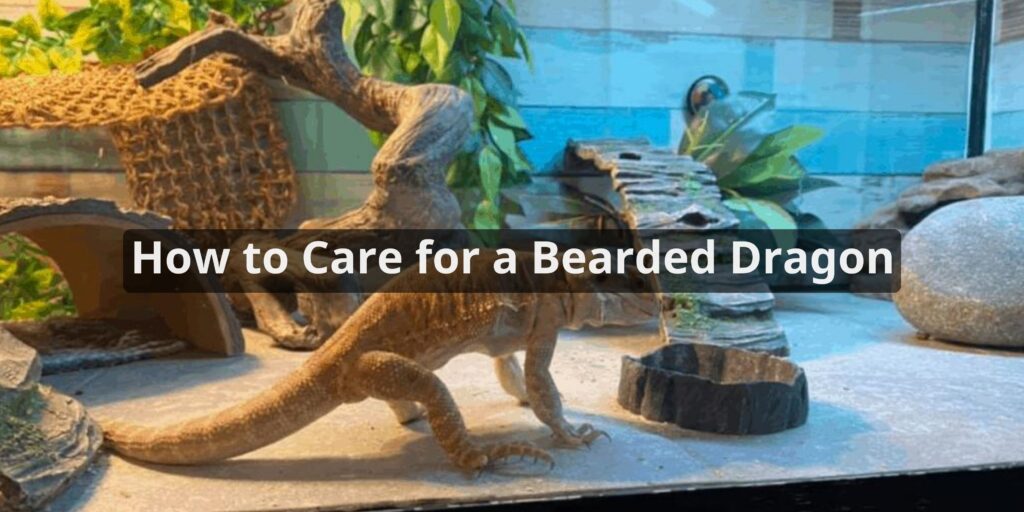Bearded dragons make great pets for beginner and experienced reptile owners alike. They are relatively easy to care for as long as their habitat and diet needs are met. Here is a guide on how to care for bearded dragon.
Housing

Bearded dragons are active reptiles that require ample space to move around. The minimum enclosure size for an adult bearded dragon is a 40-gallon breeder tank, which provides 36” x 18” floor space. Bigger is always better when it comes to bearded dragon enclosures.
The tank should have a screen lid for ventilation. Substrates like reptile carpet, paper towels, or tile work well and are easy to clean. Avoid loose substrates like sand, as it can cause impaction if ingested. Furnish the enclosure with hiding spots, climbing branches, and basking areas to enrich your bearded dragon’s environment.
Maintaining proper temperatures in the enclosure is crucial. Bearded dragons require a basking area between 95-110°F. The cooler end of the tank should be kept between 80-90°F. Use under tank heating pads, ceramic heat emitters, and basking bulbs to create a temperature gradient. The enclosure should also have UVB lighting for proper calcium metabolism.
Feeding
Bearded dragons are omnivores that need both plant and animal matter. Feed juveniles 3x a day and adults 1-2x per day. Crickets, mealworms, black soldier fly larvae, and roaches are excellent feeder insects. Dust insects with calcium/vitamin D3 powder 2-3x weekly.
Chopped up greens like collard greens, mustard greens, turnip greens, endive, and squash make great salad options. Fruits can be offered occasionally. Remove uneaten insects and greens within 24 hours to prevent mold. Do not feed spinach, avocado, iceberg lettuce, or bugs from outside due to toxicity risks. Offer fresh, clean water daily.
Handling
Bearded dragons are very handleable reptiles. Allow your bearded dragon to acclimate to its new home for 1-2 weeks before handling. Scoop up your bearded dragon gently, supporting the whole body. Avoid grabbing by the tail. Sit on the floor and allow your bearded dragon to walk from hand to hand. Keep handling sessions under 30 minutes to avoid stress.
Signs your bearded dragon is enjoying handling include closing eyes, puffing out beard, and sitting calmly in your hands. If you see black beard, gaping mouth, whipping tail, or running away, return your bearded dragon to its enclosure. Handle juveniles for only 5-10 minutes per day until they become adults.
Grooming Hygiene
Maintain proper hygiene in your bearded dragon’s habitat. Spot clean feces daily and disinfect the enclosure 1-2x a month. Replace substrate completely every 1-3 months. Wash food bowls, décor, and tanks with soap and water to prevent bacteria or mold.
Bearded dragon nails should be trimmed regularly to prevent overgrowth. Use reptile nail clippers and trim just the tip of each nail. Give your bearded dragon a warm bath 1-2x a week to aid in shedding. Use a soft brush or cloth to gently rub off any unshed skin.
Observe your bearded dragon daily for signs of illness like lethargy, lack of appetite, weight loss, or diarrhea. Take your bearded dragon to an exotic vet annually for a wellness check-up. Address any health issues promptly under the guidance of an experienced reptile vet.
Enrichment
In addition to a well-designed enclosure, provide extra enrichment for your bearded dragon. Place branches, logs, and rocks for climbing and basking. Get creative with artificial vines, tunnels, platforms, and hammocks. Rotate different décor items to keep their environment interesting.
Offer a variety of greens and vegetables to create a more stimulating, nutritious salad. Use puzzle feeders stuffed with insects to encourage natural foraging behaviors. Bearded dragons enjoy exploring outside their enclosure (supervised of course!). Let them roam in a safe reptile-proof room.
Conclusion
Caring for a bearded dragon does require a commitment of time, money, and research. But the payoff is an intriguing, docile reptile companion. Given the proper habitat setup, nutrition, and handling, bearded dragons can live up to 10 years. They exhibit charming behaviors like arm waving, changing colors, and puffing out their “beards.” With their calm personalities and manageable care needs, bearded dragons make one of the best pet lizard choices.
FAQs About How to Care for Bearded Dragon
How do I handle and interact with my bearded dragon safely?
Approach your bearded dragon calmly and support their body when handling. Start with short sessions to let them get used to you. Avoid sudden movements and loud noises, and never grab or squeeze them. Wash your hands before and after handling to prevent disease transmission.
What should I do if my bearded dragon is shedding?
During shedding, provide a humid hide (a container with damp moss) to help ease the process. Avoid peeling off shed skin; let it come off naturally. Ensure proper hydration and maintain a clean enclosure to prevent skin issues.
What are common health issues in bearded dragons, and how can I prevent them?
Common health issues include metabolic bone disease, respiratory infections, and parasites. Prevent these by providing proper lighting, heating, a clean environment, and regular vet check-ups. Ensure a balanced diet and quarantine new reptiles before introducing them.
Can I house multiple bearded dragons together, and if so, what do I need to know?
It’s generally best to house bearded dragons separately to prevent aggression, stress, and disease transmission. If you must cohabitate, ensure a larger enclosure with hiding spots, separate basking areas, and monitor for any signs of conflict or stress.
How do I create an enriching environment for my bearded dragon’s mental stimulation?
Offer a variety of textures and objects in their enclosure, like branches to climb on and rocks to explore. Rotate toys and provide puzzles or foraging opportunities. Occasionally change the layout to keep their environment mentally stimulating. Interaction with you and new experiences also help stimulate their minds.



